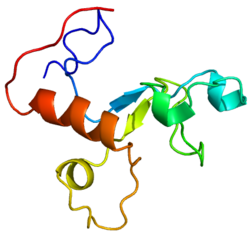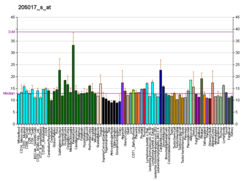| MBNL2 |
|---|
 |
| Available structures |
|---|
| PDB | Ortholog search: PDBe RCSB |
|---|
| List of PDB id codes |
|---|
2E5S, 2RPP |
|
|
| Identifiers |
|---|
| Aliases | MBNL2, MBLL, MBLL39, PRO2032, muscleblind like splicing regulator 2 |
|---|
| External IDs | OMIM: 607327; MGI: 2145597; HomoloGene: 76766; GeneCards: MBNL2; OMA:MBNL2 - orthologs |
|---|
| Gene location (Human) |
|---|
 | | Chr. | Chromosome 13 (human)[1] |
|---|
| | Band | 13q32.1 | Start | 97,221,434 bp[1] |
|---|
| End | 97,394,120 bp[1] |
|---|
|
| Gene location (Mouse) |
|---|
 | | Chr. | Chromosome 14 (mouse)[2] |
|---|
| | Band | 14|14 E4 | Start | 120,513,081 bp[2] |
|---|
| End | 120,669,109 bp[2] |
|---|
|
| RNA expression pattern |
|---|
| Bgee | | Human | Mouse (ortholog) |
|---|
| Top expressed in | - endothelial cell
- external globus pallidus
- right ventricle
- inferior ganglion of vagus nerve
- lateral nuclear group of thalamus
- subthalamic nucleus
- pars reticulata
- pons
- Pars compacta
- optic nerve
|
| | Top expressed in | - hand
- interventricular septum
- otolith organ
- utricle
- mammillary body
- lateral septal nucleus
- ventromedial nucleus
- superior cervical ganglion
- olfactory tubercle
- foot
|
| | More reference expression data |
|
|---|
| BioGPS | 

 | | More reference expression data |
|
|---|
|
| Gene ontology |
|---|
| Molecular function | - metal ion binding
- RNA binding
| | Cellular component | - cytoplasm
- nucleus
- nucleoplasm
| | Biological process | - regulation of RNA splicing
- mRNA processing
- regulation of alternative mRNA splicing, via spliceosome
- RNA splicing
| | Sources:Amigo / QuickGO |
|
| Orthologs |
|---|
| Species | Human | Mouse |
|---|
| Entrez | | |
|---|
| Ensembl | | |
|---|
| UniProt | | |
|---|
| RefSeq (mRNA) | |
|---|
NM_001306070
NM_144778
NM_207304 |
| NM_175341
NM_207515
NM_001360376
NM_001360377
NM_001360378
|
|---|
NM_001360379
NM_001360380 |
|
|---|
| RefSeq (protein) | NP_001292999
NP_659002
NP_997187
NP_001369578
NP_001369579
|
|---|
NP_001369580
NP_001369581
NP_001369582
NP_001369583
NP_001369585
NP_001369589
NP_001369590
NP_001369592
NP_001369595
NP_001369596
NP_001369597
NP_001369598
NP_001369599
NP_001369600
NP_001369601
NP_001369602
NP_001369603
NP_001369604
NP_001369605
NP_001369606
NP_001369607
NP_001369608
NP_001369609
NP_001369610
NP_001369611
NP_001369612
NP_001369613
NP_001369614
NP_001369615
NP_001369616
NP_001369617
NP_001369618
NP_001369619
NP_001369620
NP_001369621
NP_001369622
NP_001369623
NP_001369624
NP_001369625
NP_001369626 |
| NP_780550
NP_997398
NP_001347305
NP_001347306
NP_001347307
|
|---|
NP_001347308
NP_001347309 |
|
|---|
| Location (UCSC) | Chr 13: 97.22 – 97.39 Mb | Chr 14: 120.51 – 120.67 Mb |
|---|
| PubMed search | [3] | [4] |
|---|
|
| Wikidata |
| View/Edit Human | View/Edit Mouse |
|





















